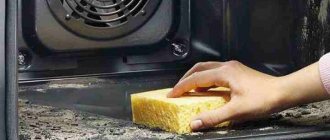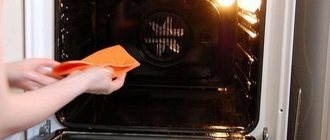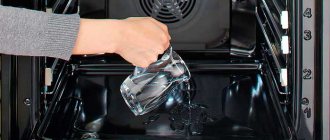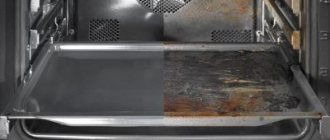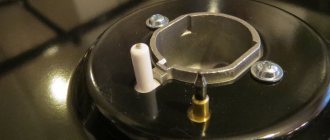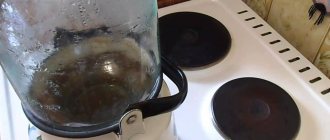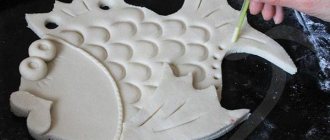Few people enjoy cleaning the oven from stubborn, sticky fat, but this process is mandatory, since cleanliness is one of the main conditions for ensuring long service life of the equipment.
Some oven manufacturers have begun to equip kitchen appliances with built-in self-cleaning functions, allowing you to get rid of dirt after cooking with minimal human intervention.
What is hydrolysis
What does steam cleaning an oven mean? This is when water is poured into the pan and the oven is heated. Then a special hydrolysis liquid is added to the water, closed again, and turned on for a short period of time. Once the water becomes hot, steam is generated, softening the dried fat. This occurs as a result of a chemical reaction. The fat flows into a special tray. However, it should be noted that heavy stains will have to be scrubbed off manually.
Household appliances with hydrolysis cleaning function are made from high quality enamel, which is resistant to food acids, so grease does not penetrate inside. When housewives are interested in what it is to clean an oven with steam, it must be said that this is not a complete cleaning. This is a kind of preparation that makes cleaning the stove easier, because it is necessary to remove the soaked grease and dirt from inside. After this, the door is left ajar for about an hour to dry. Please note that the more often you do this treatment, the easier it will be to maintain the oven.
Which ovens have a hydrolysis function?
Manufacturers of household appliances produce many different models of ovens equipped with a hydrolysis cleaning function. Prices for household products vary from 12 thousand rubles to 115-120 thousand rubles.
The most inexpensive models include ovens:
- Electronicsdeluxe 6009.01eshv-000;
- Hotpoint-Ariston FH 21 BK;
- Beko BCM 12300 X and others.
The hydrolysis cleaning function can be used in both gas ovens and electrical appliances.
Hydrolysis cleaning functions in modern ovens
A large number of modern oven models have a Cleaning function, which requires cleaning using sprays that replace steam. In this case, it must first be heated to 90 degrees. After 15 minutes, when the door opens, you need to treat the walls as quickly as possible with a special care spray and close the door.
When the oven has cooled completely, remove any traces of:
- liquids;
- spray;
- split fat.
For those who are interested in what it is to steam clean ovens of modern modifications, it is worth highlighting such a function as Aqua Clean. It operates at low temperatures. Pour 0.5 liters of water into the baking tray and set the cleaning mode. After heating the oven to 50 degrees, cleaning will be carried out for half an hour. Then the door is opened and the dirt is removed. Premium ovens with a hydrolysis program are also available. It activates cleaning, you can select the intensity and time for it on the timer.
Basic types of cleaning
It is most convenient to divide cleaning methods according to the principle of the main action, which can be achieved using the functionality of the oven or using additional detergents and devices.
Pyrolytic cleaning
This method of maintaining cleanliness works using high temperatures and does not require first emptying the oven from the baking trays. All contaminants are burned at such temperatures and all that remains is to remove the layer of soot from the walls. This method is the most effective, but has both advantages and disadvantages.
Main disadvantages:
- Ovens capable of heating to such temperatures are usually more expensive than their analogues.
- Cleaning with this method requires high energy costs
- With such heating, there is a high probability of damaging nearby furniture or equipment.
- During the cleaning process, an unpleasant burning smell appears, which is difficult to get rid of even with the hood on.
Pros:
- In this way, even the heaviest contaminants are destroyed
- No additional costs for cleaning products required
- Mechanical actions are not necessary for pyrolytic cleaning.
NOTE: Only an electric oven can be cleaned using this method, since the maximum temperature for a gas oven is considered to be 250 degrees. The pyrolytic method is most suitable for those who use the oven for cooking several times a week; in all other cases, any cleaning method at lower temperatures will be sufficient.
Catalytic purification
This cleaning method can be called the most economical, since the process can also occur during cooking. It is also worth noting its versatility; the use of the catalytic method is equally effective in both gas and electric ovens. The mechanism is based on the characteristics of the oven walls themselves; they have roughness and numerous depressions - pores. The latter contain a special substance that breaks down fats into their components; the only thing the housewife can do is wipe the surfaces of the still hot oven.
Cleaning with detergents
In this case, the main task is to choose the right detergent that will not damage the oven walls or scratch the coating. It is also necessary to thoroughly rinse off the chosen product after use, otherwise, under the influence of high temperatures, it can destroy the surface, and harmful chemical compounds can get onto dishes that are cooked in the oven. The main disadvantage is the resources spent on the cleaning process; severe contamination takes a lot of time and a lot of physical effort.
IMPORTANT:
Oven manufacturers recommend not using chemicals that contain abrasives, and also avoid cleaning with metal sponges. Such methods of maintaining cleanliness can lead to deep damage to the surface of the walls, after which even the built-in cleaning functions will not be able to work correctly.
Hydrolysis cleaning
One of the newest cleaning methods, which is based on the action of steam. Hydrolysis is carried out at low temperatures, which does not require high energy costs and also prevents excessive heating of the oven walls. To use this method, it is necessary to pour hydrolysis liquid into the baking tray, which is responsible for softening dried fat or other contaminants when the temperature rises. In this case, the fat flows into a special tray, however, if the dirt is strong, you may need to scrub it off manually, and it is not necessary to resort to the use of chemicals; the dirt can be cleaned using ordinary soda.
Hydrolysis cleaning in modern ovens
Modern technology with a hydrolysis cleaning function is produced in a special way using high-quality enamel, which in turn is resistant to dirt and does not allow it to penetrate deeply. The main cleaning work is done using hot steam; the oven must be heated from 100 to 200 degrees, depending on the severity of the contamination.
The process itself in ovens with a built-in hydrolysis function can be divided into several key stages:
- First of all, you need to remove all foreign objects and kitchen utensils from the oven.
- Next, you need to pour a small amount of water onto the bottom of the oven, 200-400 ml is enough. After this, the oven door should be closed tightly.
- The steam cleaning function should be started.
- At the end of the program, which is accompanied by a sound signal, you should turn off the oven and let it cool slightly.
- The inner walls and door should be wiped with a cloth or paper towel, and any remaining water from the bottom of the oven should be removed with a sponge.
- After completing all oven cleaning procedures, it is recommended to leave the door ajar for 10-15 minutes to allow the enamel to dry completely.
ADVICE:
It is recommended to regularly clean the oven 1-2 times a month, depending on how often you use the oven for cooking. Do not wait for heavy contamination, which will cause an unpleasant odor and may also require manual cleaning.
The pros and cons may be individual for different models of ovens, depending on the type of appliance itself (built-in or not), as well as different heating methods (gas or electricity).
pros
The main advantage is the price of the oven; the hydrolysis cleaning function does not affect the high cost and can be present both in premium appliances and in models designed for a wide market. It is also worth noting that it is cost-effective; in contrast to pyrolytic cleaning, the time required, and therefore the energy consumption, is not high; one procedure takes from 15 to 30 minutes. When using this function, high temperatures are not required; at 50-90 degrees, the wear of the internal walls is significantly reduced.
Minuses
When using the steam cleaning function, the disadvantages are not too critical, but they include the incomplete automation of the process, since after completion of the program you must wash off dirt, grease and excess water yourself. The baking tray, as well as the grates and trays included in the package, cannot be cleaned this way. Also, old or severe dirt cannot be removed in one step or requires a different cleaning method.
Flaws
There are pros and cons to this method of cleaning the oven with steam. It is necessary to clean it after the oven has completely cooled down; do not turn it on immediately after cooking. Other disadvantages are also noted:
- manual labor is not excluded;
- if there is water in the pan, there is a danger of getting burned;
- It will take a lot of time to clean up.
You should also keep in mind that steam is not able to remove very stubborn stains. Once the oven walls have cooled, it becomes very difficult to wash off any dirt from the surface.
The best oven cleaners
Manufacturers usually recommend a specific composition. To remove stubborn stains manually, it is better to purchase proven products:
- Amway is thick, stays on dirt for a long time, and is easily washed off;
- Unicum removes fresh stains quite well;
- Sanitol contains alkali, a lethal but unsafe agent;
- Faberlic starts the process of biological decomposition of fat components;
- Schumanite will make the old surface attractive;
- Dr.Beckmann – universal cleaner for ovens and dishes;
- Chistomix – safe, based on natural ingredients;
- Dirtbusters are a very effective oven cleaner.
Comparison with catalytic system
With a catalytic oven cleaning system, a special grease-absorbing enamel is applied to the surface of its walls. If you feel the walls, it becomes clear that they are rough and porous. Oil and various contaminants get into these pores. When they come into contact with special enamel, they oxidize, turning into water and soot. This self-cleaning process can be performed along with cooking, so there is no need to turn on the oven separately. Since there are no additional costs of electrical energy, this method is the most economical. After cleaning, you need to wipe off soot from the surfaces inside the cabinet with a damp cloth. If the dirt is not very strong, there is no need to use cleaning agents.
It must be taken into account that the self-cleaning process with a catalytic system starts when the oven heats up above 140 degrees. This technology is most effective when the equipment operates at a temperature of 200 degrees.
Taking into account all the advantages of this technology, it will become clear that catalytic cleaning of the oven or steam is better. It should be taken into account that the catalytic system is fully automated; no physical effort is required. This modern technology is definitely superior to hydrolysis, but the cost is higher. The high price is one of the disadvantages. Catalytic panels must be changed periodically, because during operation the coating loses its properties.
It is also necessary to keep in mind that fat-absorbing enamel is applied only to metal surfaces, namely the side, bottom and top walls. The glass located on the door will need to be washed by hand. However, unlike hydrolysis, the catalytic method is more progressive.
How to clean surfaces?
There are 2 ways to steam clean an oven. In the first case, improvised means are used for processing, for example, a baking sheet or other container. Ovens with a built-in hydrolysis function will not require additional reservoirs.
Built-in function
Ovens equipped with the Aqua Clean program are equipped with a special tank. Water is poured into it with the addition of detergents with a non-aggressive composition. During the hydrolysis process, fat drains from the walls along with dirt and ends up in a special tray for collecting dirt.
How to steam clean your oven using the built-in Aqua Clean function:
Remove kitchen utensils from the oven.- Pour water into a special reservoir at the bottom of the oven (the exact volume of liquid required is indicated in the instructions for the oven).
- Close the door.
- Start the steam cleaning function.
- When the oven beeps to indicate the end of the cycle, you need to turn off the oven and open the door.
- Use a soft cloth to wipe away any remaining moisture and wipe the walls inside the oven, simultaneously removing softened dirt.
- Wipe the surface of the oven with a dry cloth.
- Leave the oven open for 30 minutes until the interior of the cabinet is completely dry.
Manual method
If your oven does not have a built-in steam cleaning function, you can prepare a cleaning solution yourself:
- pour a small amount of water into a baking tray;
- pour in water or pour out detergent or cleaning agent;
- set the oven temperature to 100 C°;
- place a baking sheet with water and cleaning agent inside the oven;
- close the door;
- turn off the oven after 40 minutes.
Under the influence of temperature, water begins to evaporate. In combination with detergent, it acts on dirt that has settled on the walls. As a result, the plaque softens and can be easily removed with a soft cloth.
Before the hydrolysis procedure, stubborn dirt can be wiped with a concentrated solution of citric acid or lemon slices.
Hydrolysis or pyrolytic systems
In addition to the type of cleaning the oven with steam, there is another easy method to clean the oven, it is called pyrolysis. This method, when compared with catalytic and hydrolysis, is considered more advanced.
This cleaning system has a number of advantages, one of which is that contaminants are removed under the influence of high temperature, without the use of additional preparations. The dirt is completely burned, all that remains is to remove them manually.
Pyrolysis also has its disadvantages. It should be noted that products with the introduction of this cleaning system are much more expensive than analogues. Receiving high temperatures is directly related to high energy consumption. You should also keep in mind that the oven will have to be insulated during the cleaning procedure, because strong heat has a negative effect on nearby furniture.
Pros and cons of hydrolysis
Steam cleaning cannot be called a completely automatic removal of contaminants in the oven. But this treatment greatly simplifies the process of caring for the stove. Hydrolysis has its advantages and disadvantages compared to other methods
Pros:
hydrolysis will not require the cost of expensive household chemicals;- since cleaning occurs at relatively low temperatures, energy consumption is low;
- steam cleaning helps save time; After the procedure, all that remains is to remove the softened stains with a rag - this is much more convenient than scrubbing dried stains with force for a long time;
- the hydrolysis process is safe - since the exposure temperature is low, the cabinet door does not overheat and the risk of getting burned is minimal.
Minuses:
- after the procedure is completed, dirt may remain on the cabinet walls that will have to be removed manually;
- to remove stubborn stains, the cleaning procedure will have to be repeated or removed manually - for this reason, it is recommended to carry out the process of treating the oven with steam in a timely manner;
- hydrolysis can only be carried out after the oven has completely cooled; You should not organize such cleaning immediately after finishing cooking.
How to steam clean without hydrolysis technology
If the oven is not equipped with a hydrolysis function, you can still clean it with steam. You need to take a heat-resistant container or a baking sheet with high sides and pour at least 0.5 liters of water into it. Place on the lower level of the oven or at the very bottom. Turn on the oven, setting the temperature to 100-150 degrees. If there are persistent stains on the surface, it is recommended to add 50-100 ml of dishwashing liquid to the water. As soon as the water boils, dirt on the walls will begin to soften under the influence of the resulting steam. After the liquid has boiled away, turn off the oven and open the door slightly. When the walls become warm, remove the dirt manually. It is not recommended to use abrasive powders, hard brushes and sponges, as they can damage the coating.
Other oven cleaning methods
The ease of cleaning the oven depends on the materials used and built-in functions. In addition to hydrolysis, pyrolysis and catalysis are common.
Self-cleaning enamel
This is the so-called catalytic method. Glassy walls, rough to the touch, covered with pores. Enamel repels dirt well. Acts as a catalyst for the decomposition of fats at high temperatures. Fats and food particles that get on the walls break down into water and easily removed dry ingredients.
Catalysis is considered a low-temperature purification method - oxidation occurs at a temperature of 140-200°C
Attention! Enamel is destroyed by sugar and lactose. Be careful when preparing baked goods. The bottom is made of metal and will have to be washed by hand.
Application of pyrolysis
The pyrolytic process occurs at high temperatures; the metal is heated to +500°C. Fatty residues and food simply burn out. Pyrolysis is carried out with grates, baking sheets, and heat-resistant baking containers. During heat treatment, all surfaces are cleaned at once. A significant disadvantage of the models is that the treatment is accompanied by an unpleasant burning smell; the doors do not close hermetically.
The toughest and most effective cleaning method. During pyrolysis, all food remains burn to ashes.
Note! The function consumes a lot of energy; an additional 6 kW cable is connected to the ovens.
Housewives reviews
I have never tried steam cleaning an oven. My neighbor told me in detail what it is. Before this conversation, I used standard measures and spent a lot of time and effort cleaning centimeter by centimeter by hand. There is no need to spend money on buying detergent. The whole process takes no more than 15 minutes, because most of the fat is gone, and its remnants can be quickly removed by hand.
Elena, St. Petersburg
I love this method because it really saves time. Some people claim that it is impossible to get rid of all contaminants using the steam method. I don’t agree with this, because thanks to this method my oven is always clean. To ensure that no traces of dirt remain, you just need to wash the walls of the device more often. If you do this not after every meal preparation, but put it off until later, then, of course, you will have to spend a lot more time scrubbing.
Kristina, Voronezh
My daughter told me about this unique method. I used to spend a lot of detergent cleaning the oven and really didn't like it. It took a lot of time; by the time you clear all the fat, you get pretty tired. Now sometimes I also use detergent components, but much less of them is required due to steam treatment. It softens all the grease, so just drop a little stove cleaner onto a sponge and rub it along the walls. Not a trace of dirt remains, but you need to do this before the surface of the oven has cooled down.
Elena, Belgorod
Which cleaning method is better to choose?
The question arises, what type of oven cleaning will be better. There is no clear answer to this. If the oven is rarely used, you can use the catalytic method. The substances available in such models are designed for 300 hours. Then the surface will have to be changed.
The chemical reaction of fat breakdown begins at 140 ℃ and reaches maximum efficiency at 200 ℃
Pyrolytic cleaning requires high energy consumption. Therefore, many housewives prefer hydrolysis or classical cleaning. Everyone makes the decision themselves, taking into account their capabilities and operating mode of the oven.
After the oven operates in self-cleaning mode, all that remains is to wipe off the accumulated soot.
Conclusion
Hydrolysis oven cleaning removes fat deposits using steam. To use the function, enable the appropriate program in the toolbar.
Steam cleaning is a low-cost method that can be used even in simple models. Ovens with a hydrolysis function are very popular due to their good price-quality ratio.
It is worth paying attention: the more often such processing is carried out, the easier it will be to care for the stove (oven, grill, smokehouse).
Additional Solutions
The easiest way to clean the oven is to use specialized products sold in stores. Typically, such detergents are inexpensive, and one bottle lasts a long time. When using this method, you need to remember that before using the product you should moisten all surfaces with water. But such drugs are characterized by an aggressive effect, and therefore can damage the enamel on the walls of the cabinet.
Stores sell special devices that have self-cleaning enamel. Fat deposits almost do not stick to it. If something burns, you can easily get rid of such contaminants. This effect can be explained by the presence of catalyst particles in the enamel structure. The compound decomposes any fats. This method is called catalytic. It involves the use of low temperatures. To increase the efficiency of the catalytic cleaning method, install an additional grease filter.
Another method of cleaning the device is pyrolysis . It is based on the complete combustion of fat and food particles. This is the most aggressive method of combating pollution of all those described. Ashes remain in the oven chamber after use. In this case, the door to the oven is blocked and there is no way to open it yourself.
Pyrolysis puts a strain on the device, and therefore cannot be called gentle. It is available in selected Bosch and Gaggenau models.
Food particles can be burned at lower temperatures, so a level system of operation is provided here. This allows you to further save electricity.
